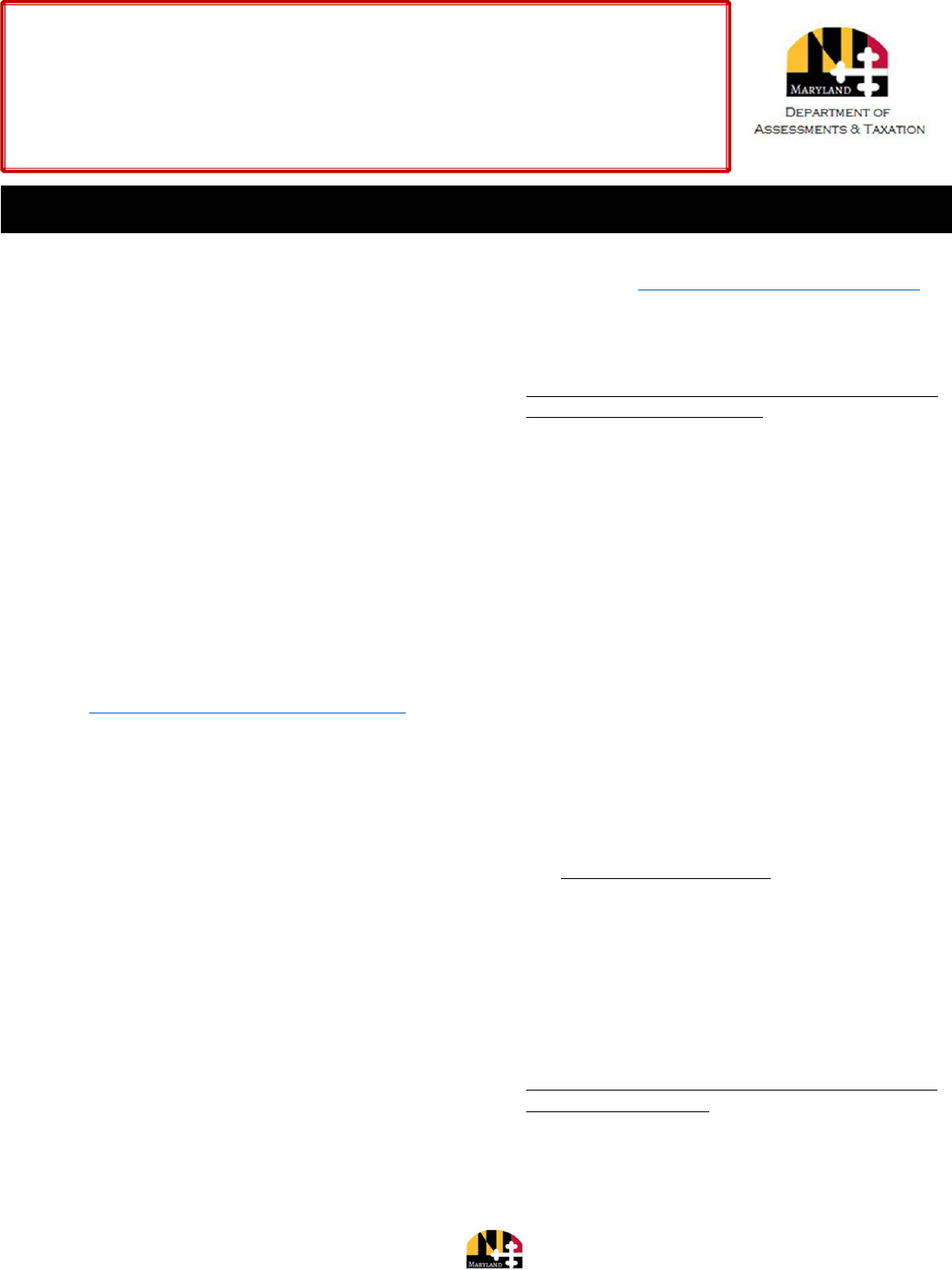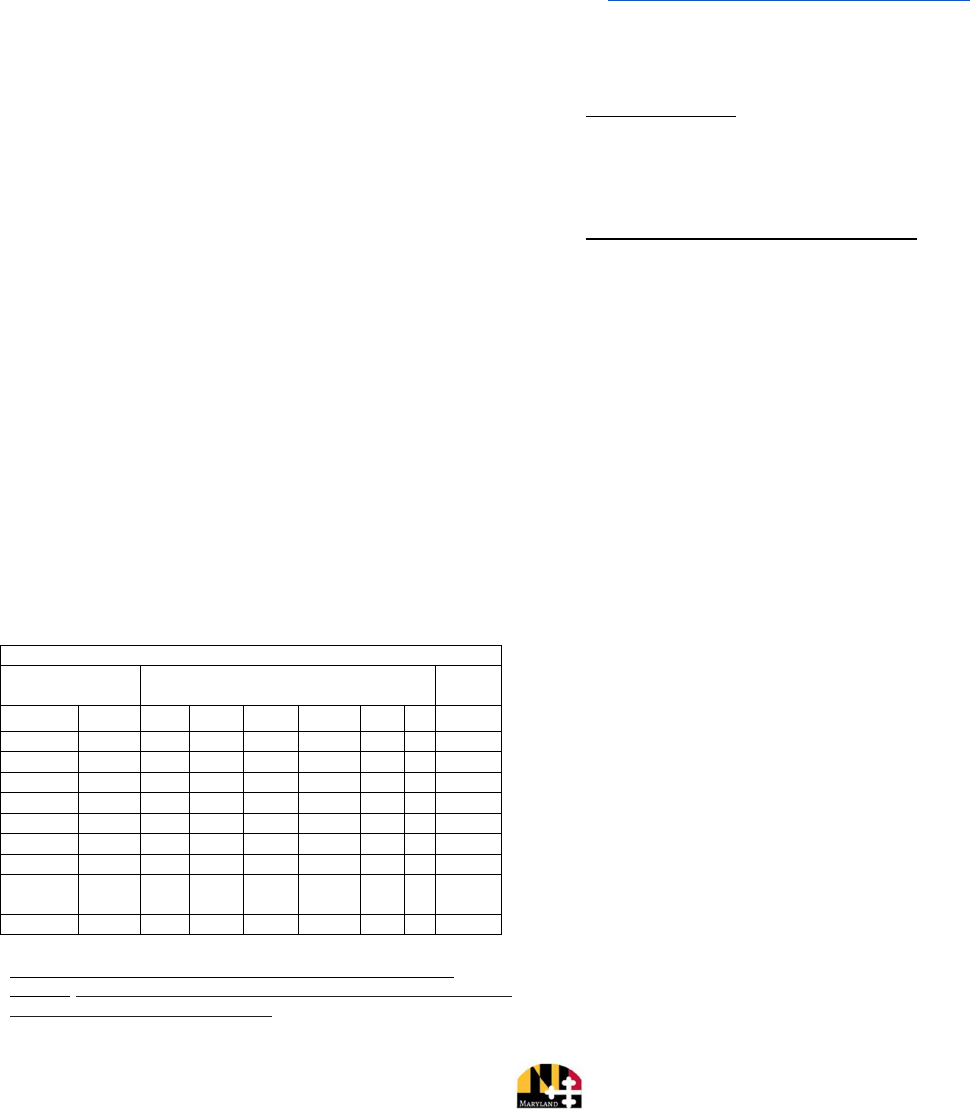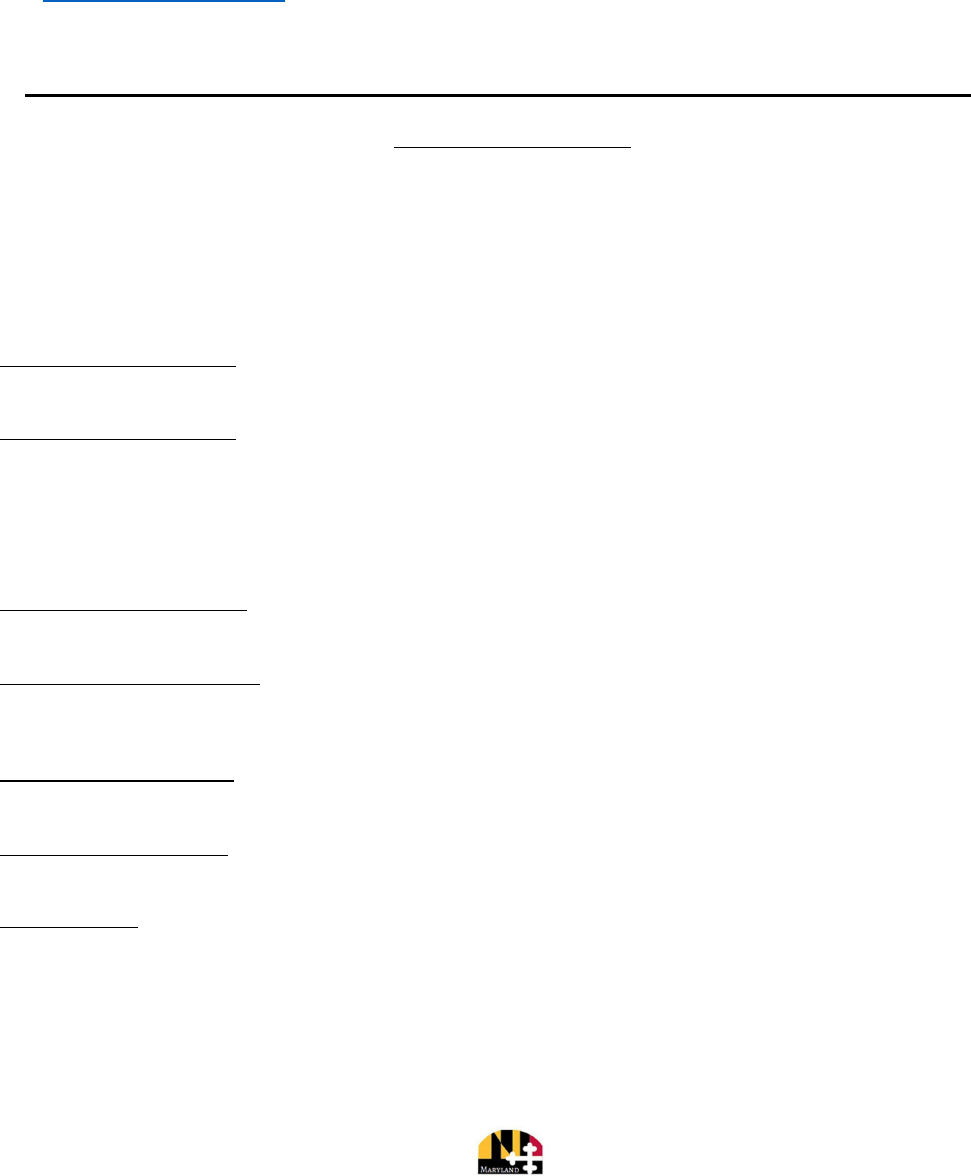
-
INSTRUCTIONS FOR FORM 2
SOLE PROPRIETORSHIP AND GENERAL PARTNERSHIPS
Business Personal Property Tax Return
General Information and Requirements
SDAT Business Personal Property
Maryland State Department of Assessments and Taxation, Business Services Unit
Business Personal Property Division, 301 West Preston Street Room 801, Baltimore Maryland 21201 1052
1)
WHO MUST FILE A RETURN
A Maryland personal property return (Form2) must be filed
by all sole proprietorships and general partnerships if they
possess (own, lease, rent, use or borrow) business personal
property or need a business license. A business which fails to
file this return will likely receive an estimated assessment.
Limited partnerships, limited liability companies and limited
liability partnerships that are registered with the
Department's Charter Division are required to file a Form 1.
2)
WHEN AND WHERE TO FILE
At the beginning of each year, the Department makes the
business personal property return available on its website. It
is the responsibility of the entity to obtain and file the return
on time. The due date for filing is April 15, of filing year.
Should April 15 fall on a weekend, the return will be due on
the Monday immediately following.
The Department encourages all customers to file
through the online portal, Maryland Business
Express (MBE) at
https://egov.maryland.gov/BusinessExpress/
If mailing your return please send to Department of
Assessments and Taxation, Personal Property
Division, P.O. Box 17052, Baltimore, MD 21297-
1052.
Amended returns or second filings are to be sent to
the Department of Assessments and Taxation,
Personal Property Division, 301 W. Preston Street,
Baltimore, MD 21201-2395.
3)
EXTENSION OF TIME TO FILE
The Department may grant a 2 month extension to file the
return.
All preparers and taxpayers with Internet access should use
the Department's website to ensure prompt and accurate
recording of an unlimited number of requests free of charge.
You will receive a confirmation number and a printed list as
proof of your submission. Always print and keep a copy of the
confirmation page. The Department will automatically accept
it as evidence of a valid approved extension in case there is
ever a problem.
You may request a 60 day extension of the filing deadline, at no
cost, by visiting http://pprextensions.dat.maryland.gov/
Extension requests must be made on or before April 15th.
Increased use of this site is anticipated as April 15
th
approaches so the Department suggests you apply for
extensions as soon as the site opens in December.
Please note that Department of Assessments and Taxation
does not accept paper extensions. No additional extension to
file will be allowed after the 2 months. Extensions approved
by the Internal Revenue Service or Maryland Comptroller of
the Treasury for income tax returns will not be accepted.
4)
FORMS
To ensure proper posting to your account always provide the
business name and your Department ID number. Please use
this number in all communications with the Department.
5)
MAILING ADDRESS CHANGES
Make necessary address corrections on the form and check
the address correction box on page 1 of the return.
6)
LATE FILING PENALTIES
A business which files an annual return postmarked after the
due date of April 15 of filing year (or June 15 if an extension is
approved) will receive an initial penalty of 1/10 of one
percent of the county assessment, plus interest at the rate of
two percent of the initial penalty amount for each thirty (30)
days or part thereof that the return is late. If returns are filed
late, you cannot pre-pay penalties at time of filing return.
They will be assessed at a later date.
7)
PERIOD COVERED
All returns shall cover the calendar year regardless of any
fiscal year. All information required in this return shall be
given as of January 1, except line items 2 and 4, which refer
to the twelve calendar months of prior year). There may be
times when supporting detail should be provided with the
return. Please see Form SD1, Supplemental Details.
Information supplied on the return and enclosures are not
open to public inspection.
8)
WHAT MUST BE REPORTED
Generally all tangible personal property owned, leased,
consigned or used by the business and located within the
Form 2 Instructions
Page 1 of 6

State of Maryland on January 1, must be reported. Property
not in use must still be reported. All fully depreciated and
expensed personal property must also be reported. Personal
property includes but is not limited to office and plant
furniture, machinery, equipment, tools, furnishings,
inventory, and all other property not considered part of the
real estate.
Personal property in this State (other than operating property
of railroads and public utilities) falls into two subclasses:
Stock in business or inventory--goods held by a
taxpayer for sale and goods placed on consignment
to another for sale in the expectation of a quick
turnover. Stock in business does not include goods
manufactured by the taxpayer but held by the
taxpayer for purposes other than sale or goods
manufactured by the taxpayer but placed in
possession and control of another as in the case of
leased property. Stock in business is assessed at cost
or market value whichever is lower. LIFO method of
valuation is prohibited.
All other personal property includes all personal
property other than inventory and is assessed at full
cash value. Taxpayers shall report such property
which has been acquired by purchase at cost in the
year of acquisition. Taxpayers shall report such
property which has been acquired other than by
purchase (including property manufactured by the
taxpayer) at what the property would have sold for
in the year of acquisition. To assess "all other
personal property" the Department generally
applies a 10% rate of depreciation per annum to the
reported property. Exceptions to the 10% rate can
be found on the Depreciation Rate Chart. Normally,
property will not be depreciated below 25% of the
original cost.
All questions must be answered in full. If the reporting
taxpayer does not own the class of property covered by any
question, the word "none" or the figure "O” should be
written in the appropriate blank space. Estimated
assessments may be issued when questions remain
unanswered or the answers are incomplete, evasive or
unclear. Real property is not to be reported on the return.
9)
EXEMPTIONS
Property tax exemptions provided by statute shall be strictly
construed. Before an exemption can be obtained the
taxpayer must show affirmatively that the exemption is
clearly allowed.
Businesses may file amended returns to correct reporting
errors or claim missed exemptions (except for missed
manufacturing exemptions) within three years of the April 15
date that the return was originally due.
SDAT Business Personal Property
For manufacturing exemption requests, an application must
be submitted on or before September 1, of the initial
assessment year or within 6 months after the date of the first
assessment notice for the taxable year that includes the
manufacturing personal property in order to qualify for the
current tax year. Section 7-104 of the Tax- Property Article of
the Annotated Code of Maryland has been revised to include
the following subsection (d) that allows the owner of
manufacturing personal property to file an application within
6 months after the date of the first assessment notice for a
taxable year that includes the manufacturing personal
property. If the application is approved, the exemption shall
be granted for the taxable year. The exception to the
September 1 deadline is applicable to taxable years beginning
after June 30, 2009. No manufacturing exemption can be
granted unless a timely application is filed. Once filed, no
additional manufacturing applications are required in
subsequent years. Exemption applications can be found on
the website,
https://dat.maryland.gov/businesses/Pages/Business-
Personal-Property.aspx.
In addition, state law requires that certain types of personal
property be fully exempt throughout Maryland from any
assessment and taxation. These include aircraft, farming
implements, residential (non-business) property, most
registered vehicles, boats not more than 100 feet in length,
customized computer software, intangible personal property
(e.g., stocks, bonds, patents, goodwill, trademarks, etc.).
Businesses owning exempt personal property described
above should report the total cost of that property on Form
SD1, Supporting Detail.
Full or partial exemptions may apply depending on the
location of the property for: manufacturing/R&D machinery
and equipment, manufacturing/R&D inventory and
commercial inventory. Contact the Department's web site for
a complete listing of these exemptions.
The law specifically includes the following activities as part of
the manufacturing process: (1) the identification, design or
genetic engineering of biological materials for research or
manufacture; and (2) the design, development or creation of
computer software for sale, lease or license.
The personal property of certain home-based businesses is
exempt if: 1) it is owned by a sole proprietorship; 2) it is
located at the owner's principal residence; and 3) its total
original cost, including inventory and excluding licensed
vehicles, is less than $10,000. An initial return must be filed
to receive this exemption. Partnerships and other legal
entities are not eligible for this exemption.
Low Assessments Tax Property Article § 7-245 A person's
personal property is not subject to valuation or to property
tax if all of the person's personal property statewide had a
Form 2 Instructions
Page 2 of 6

SDAT Business Personal Property
total original cost less than $2500. This exemption shall take
effect July 1, 2018, and shall be applicable to all taxable years
beginning after December 31, 2018.
ROUNDING
Round cents to the nearest whole dollar. Fifty cents and
above should be rounded to the next highest dollar.
10)
AUDIT OF RETURN
All personal property assessments, and any information and
figures reported on the personal property return,
accompanying schedules and related documents are subject
to audit. As a result of such audits, the Department may issue
corrected assessments.
11)
TRANSFER OF PROPERTY
If a business transfers, sells, or disposes of all personal
property on or after January 1, and before July 1, it must
notify the Department in writing on or before October 1, of
the applicable assessment year. The notification must contain
an itemized description of the property involved, the date
and manner of transfer and name(s) and address of the new
owner(s) of the property, the consideration received, and a
copy of the sales agreement (if available). Upon proper
notification and compliance with Section 10-402 of the Tax
Property Article, the assessment shall be transferred to the
new owner(s). See Form 21.
12)
OUT OF BUSINESS
If a business discontinues operations or goes "out of
business" prior to January 1 of filing year, a return or letter of
explanation detailing the date the business ceased operations
and what happened to the property must be filed. Failure to
provide this information will result in an estimated
assessment being made against the business.
13)
AMENDED RETURNS
Amended returns can be filed to correct reporting errors or
claim a missed exemption (except for missed manufacturing
exemptions see item 9) within 3 years of the April 15 date
that the return was originally filed.
Amended returns must be accompanied by information
explaining why the amended return is being filed and
reconciling the differences with the original return. Write the
word "AMENDED" across the top of page 1 of the return.
14)
TRADER’S LICENSE
Sometimes businesses requiring a trader's license experience
problems in obtaining one. Most of these problems are the
result of one or more of the following five situations:
1)
Failure to file a personal property return (previous year).
2)
Failure to report commercial inventory on the personal
property return (previous year).
3)
Unpaid personal property taxes (previous year).
4)
Unpaid late filing penalty owed toSDAT.
5)
Failure to register with SDAT.
6)
"If you are unsure of whether this applies to you,
SPECIFIC INSTRUCTIONS FOR FORM 2
SOLE PROPRIETORSHIP AND GENERAL PARTNERSHIPS
please contact your county's Clerk of the Court
at https://www.courts.state.md.us/pia/clerks. Maryland
Annotated Code, Business Regulation Article §17-1808
allows counties and municipalities to adopt a Uniform
Trader's License Fee."
Form 2 Instructions
Page 3 of 6

SDAT Business Personal Property
SECTION I
1.
Check one: Sole Proprietorship (one owner) or
General Partnership (two or more owners)
2.
Provide the name of owner orowners.
3.
Provide the complete mailing address for the
business. If this is a new mailing address, check the
box to the left.
4.
Provide the SDAT Department ID number. To
obtain the Department ID, go to Maryland Business
Express,
http://egov.maryland.gov/BusinessExpress/EntitySea
rch The ID number is necessary to ensure proper
credit to the account.
5.
List federal employee ID# (FEIN). If none,
provide social security number of owner.
6.
List federal principal business code. It can be
found on IRS Schedule C or Form 1065.
7.
Provide the nature of business activity in
Maryland(e.g., restaurant, legal services,
construction,etc.)
8.
Total gross sales must include sales in Maryland
and sales by the Maryland location to out of state
purchasers as well as transfers from the Maryland
location of the reporting business to out of state
locations.
SECTION II
A.
Please provide the actual physical location of all
personal property in Maryland. P.O. Boxes are not
acceptable. Indicate if this is a change of location.
Only an individual who owns a business should
answer questions B and C
B.
Answer yes, if the location in number 3
aboveis the principal residence of the
business owner.
C.
Answer yes, if the total original cost of the
property, including inventory and excluding
licensed vehicles, is less than $10,000. If both
questions A and B are answered yes, the business
is exempt from personal property assessment and
taxation. Skip to signature line on page 3.
D.
Indicate whether business owns, uses or
leasesany personal property in Maryland.
E.
Answer yes, if the business requires a license to
operate with any county/town in Maryland.
F.
Indicate whether or not business is
conductedin Maryland. If yes, specify date
began.
G.
If the business operates on a fiscal year, provide
the start/ end dates. If it operates on a calendar
year, you may leave this item blank.
H.
Does the business own or use any property that is
fully depreciated and/or expensed? If yes, is it
reported on this return? If the business owns or uses
this type of property but does not report it on the
return, please comment in remarks section.
Form 2 Instructions
Page 4 of 6

I.
Has the business disposed of or transferred any assets in or
out of Maryland? If yes, please comment in remarks and/or
complete Form SD1 (SupplementalDetails).
SECTION III
LINE ITEM 1
1.
Furniture, fixtures, tools, machinery and equipment not
used for manufacturing or research and development.
Includes but is not limited to office furniture, fixtures and
equipment, factory equipment and machinery, shelves,signs,
counters, etc.
This form allows detailed reporting of property which falls
under the different rates of depreciation. All property is to be
reported under Category A unless specifically listed in
another category.
Refer to the Depreciation Rate Chart to determine where
property owned by the business should be reported (see
sample below). Property reported in columns B through G
requires a detailed description (e.g., Column C - Vending
Machines, Copiers, etc.). Failure to provide the required
detail will result in the reported property being assessed at
10% rate of depreciation.
This property shall be reported at original cost in the year of
acquisition without deduction of depreciation, investment
credit or trade-in of previously owned property. Include all
fully depreciated personal property and property expensed
under IRS Rules.
EXAMPLE
Property reported on this line item should be placed under
the proper depreciation rate column by the year of
acquisition. An example of the correct method of filling out
this section is provided for reference. Property reported in
categories B through G require an explanation on the lines
provided below the box. If additional space is needed to show
the necessary detail, attach a supplemental schedule.
ORIGINAL COST BY YEAR OF ACQUISITION
SPECIAL DEPRECIATION RATES B-G (See
chart)
TOTAL
COST
A
B
C
D
E
F
G
2014
2013
1150
12800
13,750
2012
3104
8400
11,504
2011
1500
5261
6,761
2010
2009
2500
2,500
2008
9127
500
9,627
2007 &
prior
Totals
14881
3000
5261
21200
44,142
SDAT Business Personal Property
LINE ITEM 2
Commercial Inventory is merchandise and stock in trade
available for sale. This includes manufactured products sold
at retail by the manufacturer. An average of twelve (12)
monthly inventories should be reported including two (2)
physical inventories. Book inventories may be used for
months when physical inventories were not taken. Values are
to be reported at cost or market value. The LIFO method is
prohibited in computing values. If there are multiple locations
of inventory in Maryland they must be reported by each
location. Businesses that need a Trader's License must
report commercial inventory.
"If you are unsure of whether this applies to you, please
contact your county's Clerk of the Court
at https://www.courts.state.md.us/pia/clerks. Maryland
Annotated Code, Business Regulation Article §17-1808
allows counties and municipalities to adopt a Uniform
Trader's License Fee."
Rental equipment including but not limited to video tapes,
stereos, televisions, tools, appliances and furniture is not
considered commercial inventory. These assets must be
reported in Part B item.
Leased property and off rent equipment are not considered
commercial inventory and should be reported on a separate
schedule showing the names and addresses of lessees, lease
numbers, description of property, installation date and
original cost by year of acquisition for each location. Schedule
should group leases by county where the property is located.
LINE ITEM 3
Supplies. Supplies are consumable items not held for sale
(e.g., contractor's supplies, office supplies, etc.). Report the
average cost.
LINE ITEM 4
Manufacturing/R&D Inventory is raw materials, supplies,
goods in process and finished products used in and resulting
from manufacturing by the business. Include manufactured
products sold at retail by the manufacturer under line item,
commercial inventory. An average of twelve (12) monthly
inventories should be reported including two (2) physical
inventories. Book inventories may be used for months when
physical inventories were not taken. Values are to be
reported at cost or market value. The LIFO method is
prohibited in computing values. If there are multiple locations
of inventory in Maryland they must be reported by each
location.
Describe property identified in B - G above: Category D2011 Personal
Computer;
CategoryE-2012,2013 Rental DVDs and Video Tapes, 2008 Vending Machine;
Category C
- 2009 Copier $2,000, Fax $500
Form 2 Instructions
Page 5 of 6

SDAT Business Personal Property
INFORMATION AND ASSISTANCE
General questions regarding valuation and assessment
procedures : 410-767-1170, Toll Free within Maryland: 1-
888-246-5941 Maryland Relay Service - 1-800-735-2258
TT/VOICE
(Maryland Relay Service for speech and hearing impairment) Email:
Online Services: Filing Extensions, Online Filing & Forms:
https://dat.maryland.gov
Form 2 Instructions
Page 6 of 6

LINE ITEM 5
Tools, machinery and equipment used for
manufacturing or research and development. Answer this
question in detail even though such property may by law or
resolution be exempt. Reporting property on this line item is
not a substitute for a manufacturing application. If exemption
is claimed for the first time, a manufacturing/research &
development exemption application must be submitted on or
before September 1 of filing year before the exemption can
be granted, or within 6 months after the date of the first
assessment notice for the taxable year that includes the
manufacturing personal property in order to qualify for the
current tax year. Section 7-104 of the Tax-Property Article of
the Annotated Code of Maryland has been revised to include
subsection (d) that allows the owner of manufacturing
personal property to file an application within 6 months after
the date of the first assessment notice for a taxable year that
includes the manufacturing personal property. If the
application is approved, the exemption shall be granted for
the taxable year. The exception to the September 1 deadline
is applicable to taxable years beginning after June 30, 2009.
No manufacturing exemption can be granted unless a timely
application is filed. Once filed, no additional manufacturing
applications are required in subsequent years. Contact the
Department or visit our web site at www.dat.maryland.gov to
obtain an application. This property shall be reported at
original cost in the year of acquisition without deduction of
depreciation, investment credit or trade-in of previously
owned property. Include all fully depreciated personal
property and property expensed under IRS rules.
For manufacturing the primary test for exemption requires
substantially transforming, or a substantial step in the
process of substantially transforming tangible personal
property into a new and different article by use of labor or
machinery. The term manufacturing does not include
products mainly intellectual, artistic or clerical in nature,
services, public utility services, or property used primarily in
administration, management, sales, storage, shipping,
receiving or any other non-manufacturing activity.
Research and development means basic and applied research
in the sciences and engineering, and the design, development
and governmentally required pre-market testing of
prototypes, products, and processes. Research and
development activities are exempt whether or not the
company has a product for sale.
The following activities do not constitute research and
development: market research; research in social sciences,
psychology, or other nontechnical activities; routine product
testing; service activities; sales; or research and development
of a public utility.
6.
Vehicles: Itemize motor vehicles with Interchangeable
Registrations and vehicles that are unregistered (unlicensed).
Vehicles registered in Maryland and classified A-P are
exempt
SDAT Business Personal Property
and should not be reported on the Personal Property Tax
return. Vehicles registered outside Maryland may also be
exempt. Exempt vehicles include those registered in another
taxing jurisdiction and of a classification (A-P) described in
Title 13, Subtitle 9, Part II of the Maryland Transportation
Article.
Interchangeable Registrations include: dealer plates (Class
1A, 1B, 1C); recycler plates (Class 2); finance company plates
(Class 3); special mobile equipment plates (Class 4); and
transporter plates (Class 5).
This property shall be reported at original cost in the year of
acquisition without deduction or depreciation, investment
credit, or trade-in of previously owned property. Include all
fully depreciated personal property and property expensed
under IRS rules.
Motor vehicles with Interchangeable Registrations and
unregistered/unlicensed vehicles are not exempt and will be
assessed as Category C property at 20% depreciation per
annum (subject to a minimum assessment of 25% of the
original cost).
7.
Non-farming Livestock: Report book value andmarket
value.
8.
Other Tangible Personal Property: Include other tangible
personal property not reported elsewhere on this return.
Report total cost on the return and supply a separate
schedule including a description, the original acquisition cost,
and the date of acquisition of the property. Please see
additional instruction under Other Personal Property
Assessment Exemptions.
9.
Property Owned by Others and Used or Held by the
Business: All property that is not owned by the businessbut
is held by the business as lessee, on consignment, or
otherwise must be reported.
File separate schedule showing names and addresses
of owners, lease number, description of property,
installation date and separate cost in each cost.
10.
Property Owned by the Business and Used or Held by
Others: All property that is owned by the business but is
held by others as consignee, lessee or otherwise must be
reported.
All leased property must be reported, including
manufacturing equipment, and property leased to taxexempt
organizations.
Manufacturer lessors shall report property which has been
acquired other than by purchase at the retail selling price in
the year the property was manufactured (including property
manufactured by a business for its own use). Manufacturing
lessors may not report this property using the cost of
manufacture.
Form 2 Instructions
Page 7 of 6

SDAT Business Personal Property
A separate schedule showing the names and addresses of
lessees, lease numbers, description of property, installation
date and original cost by year of acquisition for each
location must be supplied. Provide the physical street
address of lessees. Post Office Box numbers are not
acceptable.
Excel schedules of leasing data may be submitted.
Verify that the entity name and ID number are
prominent on the schedule. Schedule may be filed
electronically and submitted to
sdat.persprop@maryland.gov
SIGNATURE AND DATE
The return must be signed by an owner or partner. This
signature must be an original not a copy. The date should
reflect the date the return was signed by the owner or
partner and sent to the Department. Please include
requested phone number and E-mail address to assist us in
resolving potential discrepancies.
DEPRECIATION RATE CHART
STANDARD DEPRECIATION RATE
Category A: 10% per annum*
All property not specifically listed below.
SPECIAL DEPRECIATION RATES (The rates below apply only to the items specifically listed. Use Category A for other assets.)
Category B: 20% per annum*
Mainframe computers originally costing $500,000 or more.
Category C: 20% per annum*
Autos (unlicensed), bowling alley equipment, brain scanners, car wash equipment, contractor's heavy equipment (tractors,
bulldozers), fax machines, hotel, motel, hospital and nursing home furniture and fixtures (room and lobby), MRI equipment,
mobile telephones, model home furnishings, music boxes, outdoor Christmas decorations, outdoor theatre equipment,
photocopy equipment, radio and T.V. transmitting equipment, rental pagers, rental soda fountain equipment, self-service
laundry equipment, stevedore equipment, theatre seats, trucks (unlicensed), vending machines, x-ray equipment.
Category D: 30% per annum**
Data processing equipment and other computer based equipment, canned software.
Category E: 331I3% per annum*
Blinds, carpets, drapes, shades. The following applies to equipment rental companies only: rental stereo and radio
equipment, rental televisions, rental video cassette recorders and rental DVDs and video tapes.
Category F: 50% per annum*
Pinball machines, rental tuxedos, rental uniforms, video games.
Category G: 5% per annum*
Boats, ships, vessels, (over 100 feet).
Long-lived assets
Property determined by the Department to have an expected life in excess of 10 years at the time of acquisition shall be
depreciated at an annual rate as determined by the Department.
* Subject to a minimum assessment of 25% of the original cost.
** Subject to a minimum assessment of 10% of the original cost.
Form 2 Instructions
Page 8 of 6
